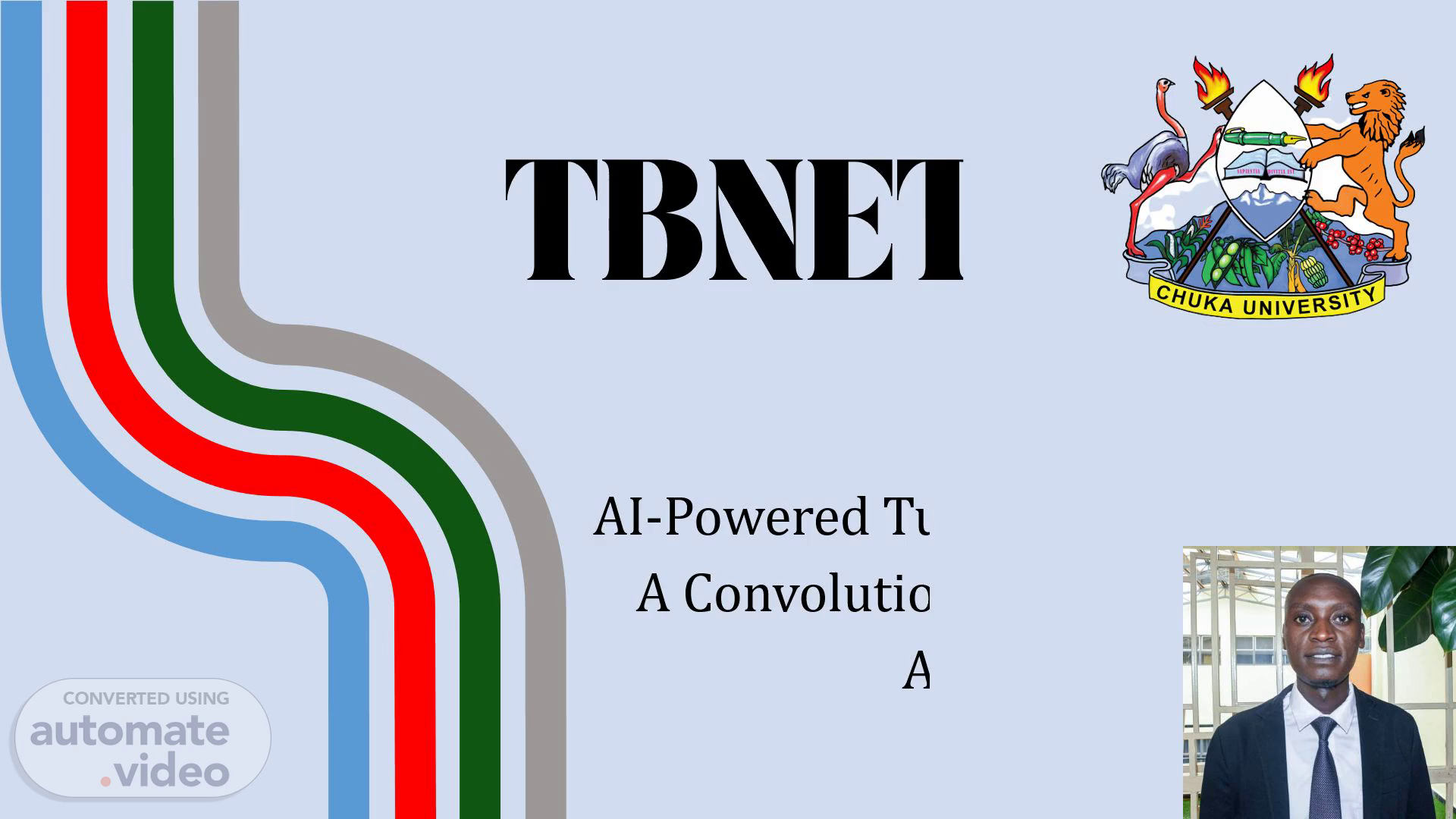Scene 1 (0s)
TBNET. AI-Powered Tuberculosis Diagnosis: A Convolutional Neural Network Approach.
Scene 2 (8s)
Dr. Edna Too Dr. David Mwathi Prof. Lucy Gitonga,O.G.W Saif Kinyori Pauline Mwaka.
Scene 3 (19s)
Tuberculosis Overview. Tuberculosis is an infectious disease caused by the bacterium Mycobacterium tuberculosis. It primarily affects the lungs and is transmitted through the air when an infected person coughs or sneezes. TB is now the largest infectious disease killer in Kenya (USAID) It is the fifth greatest cause of death (MoH, 2020)..
Scene 4 (37s)
Tuberculosis Overview. While conventional TB tests have been rampantly used in across the country, WHO advises on the need to incorporate X-ray image screening for the detection of TB. However, this approach is faced by the challenge of scarcity of radiologist experts in most of the TB prevalent regions. Therefore, finding a more viable alternative for accurately screening the X-ray images would be a relief..
Scene 5 (58s)
Deep learning techniques have gained considerable attention in the radiology area. However, most of the deep Convolution Neural Networks (CNN) architectures are large and resource intensive making them computationally expensive. Therefore, this study proposes to optimize the efficiency of CNN for the task of detecting TB using Xray images through the pruning technique..
Scene 6 (1m 17s)
Proposed solution. CHUKA UNIVERSITY.
Scene 7 (1m 24s)
Methodology. Training: Public available dataset containing 4200 Xray images Datasets for testing our model was acquired from level 4 and level 5 hospitals in Embu, Tharaka-Nithi and Meru counties.
Scene 8 (1m 37s)
Model Training and Evaluation. For an experimental evaluation, we applied our proposed LighNet method to several state-of-the-art neural network architectures in the domain of image classification: xception, EfficientNet, MobileNet, ResNet50, DenseNet with 121,169 and 201 layers. TensorFlow Model Optimization (TF MOT) was used to implement pruning in the DenseNet121 architecture. All networks were trained using SGD, 50 epochs , a batch size of 32, and initial learning rate is 1E–2. Basic augmentation: zooming, shearing, brightness , vertical and horizontal shifting were done on the images..
Scene 9 (2m 4s)
Model evaluation. Confusion matrix. CHUKA UNIVERSITY.
Scene 10 (2m 17s)
Prototype. https://fdab7a3c24a70702fa.gradio.live.
Scene 11 (2m 25s)
RESULTS AND ANALYSIS. Training and validation loss and accuracy curves of DenseNet121.
Scene 12 (2m 34s)
Training and validation loss and accuracy curves of EfficientNet.
Scene 13 (2m 42s)
Training and validation loss and accuracy curves of ResNet50.
Scene 14 (2m 50s)
Training and validation loss and accuracy curves of Xception.
Scene 15 (2m 59s)
Training and validation loss and accuracy curves of DenseNet169.
Scene 16 (3m 7s)
Training and validation loss and accuracy curves of MobileNetV2.
Scene 17 (3m 15s)
CHUKA UNIVERSITY. Performance comparative table for the Models and their pruned variant.
Scene 18 (3m 23s)
A line graph comparing the performance of models and their pruned variants.
Scene 19 (3m 32s)
CHUKA UNIVERSITY. A line graph showing the model’s sizes and their accuracies.
Scene 20 (3m 41s)
Confusion Matrix. DenseNet121 Confusion Matrix. PDenseNet Confusion Matrix.
Scene 21 (3m 50s)
Correctly predicted images for Normal Class (0). Sample Predictions.
Scene 22 (3m 57s)
Correctly predicted images for Normal Class (0). Sample Predictions.
Scene 23 (4m 5s)
Misclassifications.
Scene 24 (4m 11s)
Model prototype. CHUKA UNIVERSITY.
Scene 25 (4m 18s)
CHUKA UNIVERSITY. Correctly classified images (Test images- from Tharaka Nithi hospitals).
Scene 26 (4m 26s)
Correctly classified images (Test images- from Tharaka Nithi hospitals).
Scene 27 (4m 32s)
Correctly classified images (Test images- from Tharaka Nithi hospitals).
Scene 28 (4m 40s)
Challenges and Limitations. Despite its potential, the CNN may face challenges such as access to technology and data privacy concerns. Addressing these limitations is crucial for the successful integration of this advanced diagnostic tool into healthcare systems..
Scene 29 (4m 55s)
Future Research Directions. Further research is needed to enhance the capabilities of the CNN for Tuberculosis detection, including refining algorithms, expanding datasets, and exploring potential applications in other medical conditions..
Scene 30 (5m 8s)
Collaborative Partnerships. Collaboration between healthcare institutions, technology developers, and researchers is essential to advance the CNN technology and ensure its successful integration into clinical practice for Tuberculosis diagnosis..
Scene 31 (5m 21s)
CHUKA UNIVERSITY.
